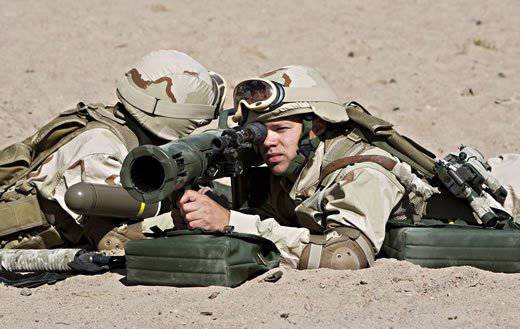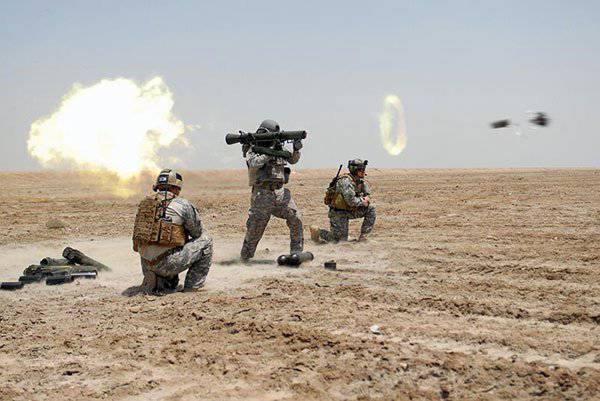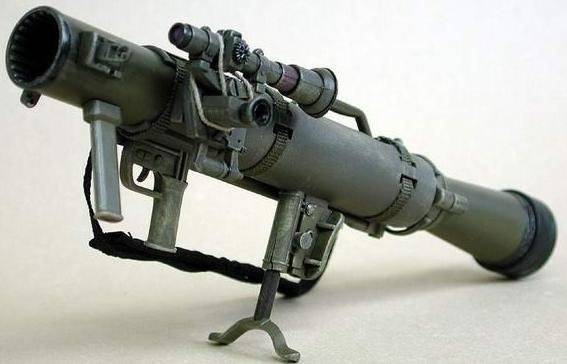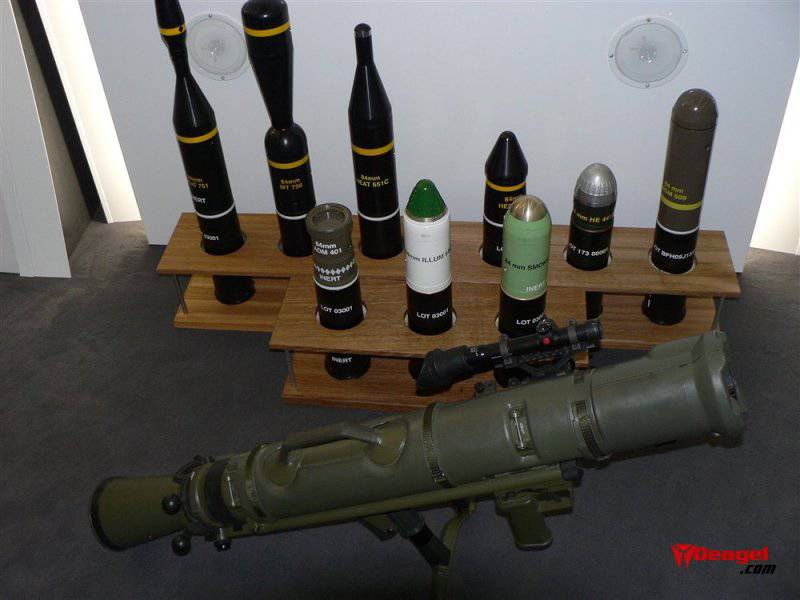The United States for the first time adopted the Swedish anti-tank gun Carl Gustaf M3

The US military together with the command of the forces of special operations purchased the recoilless anti-tank guns Carl Gustav M3 from the Swedish company Saab. The contract value is 31.5 million dollars. This is the first acquisition by the United States of Swedish PTBO.
Anti-tank recoilless gun made on the basis of anti-tank gun Pvg m / 42, developed in 41 year, Mr. Abramson. The tasks performed by “M2 / M3 Karl Gustav” PTBO allow us to call it multipurpose weapons. The breech-rifled rifle recoilless weapon, reduced to the size of an RPG, has a caliber of 84 mm, designed for use in ground forces units.
The M2 / M3 Karl Gustav anti-tank gun without rifles is designed to destroy any enemy armored vehicles, armored fortifications and enemy personnel.
PTBO device.
Anti-tank recoilless gun consists of fixtures, retention, sight, firing mechanism, rifled barrel with breech. The breech is connected to the barrel by the hinge method and has a socket and nozzle. To charge the PTBO, it is necessary to use the locking ring on the breech, turning it, then raise the breech along the longitudinal axis to the left and up, lay a grenade and return the breech into place and close it with the ring.
Serving calculation produces approximately 5-7 shots per minute. The charger is positioned behind the shooter and slightly to the side. To increase the rate of fire, the loader can put a special boot on the nozzle of the gun to reduce the likelihood of getting burned when loading the PTBO.
Note the precautions taken on the PTBO: for a shot to be fired, the breech must be completely closed (the triggering device will not respond to the shooter’s actions until the breech is closed to the end). After firing, the empty case is either thrown out by itself, or it is pushed out by the next grenade. The device for lowering the ammunition is to the right of the barrel; in order to put him in a fighting position, you need to move the lever, which is located near the pistol grip, forward. On the handle itself has a safety lever.
Under the barrel there is a casing, shoulder support, pistol grip and gun holding handle, located in front. In front of the shoulder rest, a special double support bipod is attached, which is necessary when firing from the shelters and from the side of the machines. It is possible to mount this bipod near the muzzle end of the barrel. The belt for moving the anti-tank recoilless gun is fastened on the right side of the barrel.
Used ammunition.
Shots unitary execution developed by the company FFV. Ammunition is assembled in the sleeve itself with holes near the bottom. The holes of the grenade are closed with a plastic disk, this ensures the creation of pressure for the production of the movement of the grenade through the barrel channel and the acquisition of its initial velocity. The disk under pressure is destroyed, and gunpowder gases, which exit through the nozzle, begin to escape through the holes, compensating for the return from the shot. The grenades for this gun had a leading plastic belt for obturation, and in flight the grenades were stabilized by rotation.
The cumulative ammunition FFV65 was equipped with a head-feeding fuse and a rod piezoelectric element, which ensured the operation of the cumulative ammunition at a given distance from the barrier. The fuse platoon occurred during the flight of the munition, in addition, the cumulative grenade was provided by the tracer.
FFV441 fragmentation ammunition inside contains spherical fragments, provided with a remote fuse.
FFV545 lighting ammunition can illuminate a space of 500 square meters within 0.5 minutes.
Smoke ammunition creates a smoke screen equal to 15 meters.
The dual-purpose ammunition FFV502 is intended to destroy lightly armored vehicles at a distance of a quarter of a kilometer and defeat enemy personnel at a distance of up to one kilometer. It has a cumulative charge and half-ready fragments. A distinctive feature of this munition in the detonation of the fuse: based on the tasks, the ammunition can form a cumulative jet or create a high-explosive fragmentation effect.
For training purposes and training staff used a practical ammunition, which had a barrel with a 6.5 mm rifle, and then had a rifle chambered for 9 mm with a tracer to simulate the flight of a used grenade to a distance of 0.4 kilometers.
The sight of the PTBO "M2 / M3" was a twofold magnification and a viewing angle of 17 degrees. Also, the sight was provided with a device for introducing a correction for temperature and side wind. The sight of mechanical performance on the instrument had auxiliary functions.
In 1964, a modification of the recoilless anti-tank weapon called M2-550 Carl Gustaf appeared. PTBO received new ammunition and improved sight.
Active-reactive ammunition FFV551 cumulative performance received sharp fairing, jet-powder engine. The grenade stabilizer has six feathers and is foldable. Thanks to the pyro retarder, the engine is switched on after a grenade flight of 18 meters and performs its function to disperse ammunition to 380 m / s in approximately one and a half seconds.
Due to this, the aiming range increases to 0.7 kilometers.
A new FFV441B ammunition is produced, which has a jumping fragmentation element. Practical ammunition for the gun gets loose barrel 7.62 mm.
M2-550 PTB Carl Gustaf can use previously fired munitions for M2 / M3 for firing.
Improved sight FFV555 gets a threefold increase, equipped with a monocular range finder with a ballistic computer. The viewing angle has slightly decreased - to 12 degrees.

Anti-tank "M3 Carl Gustaf".
In 1991, the M3 Carl Gustaf modification appears. PTBO receives a thin-walled steel barrel in a plastic case. The surface of the casing is reinforced with fiberglass. Many steel parts are replaced by analogues of plastic and aluminum. Due to this, the PTBO weight decreased to 8.5 kilogram. The M3 Carl Gustaf sight gets a laser range finder. Some modifications were subject to containment.
Available over-caliber 135-mm ammunition FFV597 cumulative performance. 8 grenade mass kilogram, armor-piercing 90 centimeters. Ammunition is charged into the gun from the muzzle side.
One of the drawbacks of anti-tank BO is a large acoustic load equal to 184 dB. But due to good accuracy of defeat, ease of use, good mobility and multipurpose nature, the anti-tank recoilless weapon became the most popular in the world. It is in service with very many countries, produced under license in France.
Another of the important characteristics of the Swedish anti-tank BD is its relatively low cost, even with special CLASS units it is much cheaper than its competitors.

The main characteristics of M3 Carl Gustaf:
- caliber 84 mm;
- length 1.1 meter;
- The initial speed of the ammunition from 240 to 310 m / s;
- maximum ammunition speed from 310 to 380 m / s;
- weight with sight - 9,6 kg
Target range:
- up to 300 meters in moving vehicles;
- Up to 700 meters on a fixed target;
- up to 1 kilometer enemy personnel;
- up to 1.3 kilometer use of smoke ammunition;
- Up to 2.3 kilometer use lighting ammunition;
- service personnel - 2 person.
Additional Information.
Earlier it was reported on the delivery of Australia 437 anti-tank BO "Carl Gustav M3" with thermal sights. The cost of this batch of grenade launchers is estimated at 110 million dollars.


Information